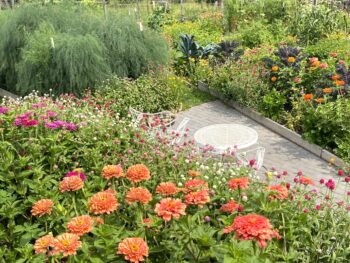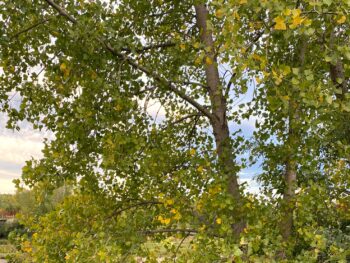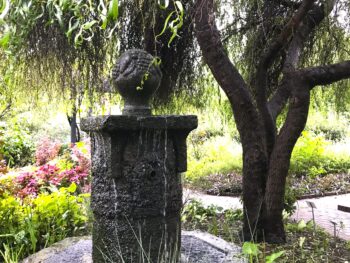I am staring at our bramble bushes, bursting in delight, for the bushes are bursting in berries. How we have anticipated this moment! With my constant garden babble, my husband’s heart began stirring with his own childhood garden memories…of boysenberries. To hear him tell it, they had bramble-acres, though perhaps he blended visions from trips to nearby Knott’s Berry Farm with his own southern California backyard.
Regardless, my husband is adorably persuasive, and I cleared a corner of lawn last year to plant Rubus ursinus x idaeus, rekindling his childhood passion (burning obsession??). Here I am, captivated by our very own bushes. Never mind the controversies ahead—whether to make jelly or cobbler, to just eat them fresh, or drizzled with honey?! This moment, which will be brief, being a short-seasoned bearer, is a time to behold.
And the angel of the LORD appeared unto him in a flame of fire out of the midst of a bush: and he looked, and, behold, the bush burned with fire, and the bush was not consumed.
Exodus 3:2 KJV
Bible Brambles
Searching the Bible for brambles brings its own controversies—and longstanding passion. The type of bush Moses saw on the mountain of God is not revealed specifically, breeding debates and speculations among scholars. The bush was thought to be thorny due to the origins of the Hebrew word “bush” spoken in this Scripture, leaning many towards the bramble genus, Rubus, in the Rose family. Most Rubus branches are peppered with small, prickly thorns.
Now that I’m a bramble gardener, I am inclined to agree.
St. Catherine’s Monastery, a cloistered community established in the sixth century, fiercely guards a bush of Rubus sanctus. The community contends that the bramble growing there when the monastery was formed was the same bush Moses saw burning but not consumed. This holy horticulture drew followers to the site as early as the third century. The Chapel of the Burning Bush stewards the sanctity of the holy ground; travelers and pilgrims today continue to trek to this Sinai outpost.
Burning Fire
The fire burning in the bramble was preamble—a hint of God’s power soon to be dispatched in his Word, later to be dispensed in his Spirit. To this very place where Moses was commissioned to deliver the Israelites from slavery in Egypt—
Now Moses…led the flock to the far side of the wilderness and came to Horeb, the mountain of God. There the angel of the Lord appeared to him in flames of fire from within a bush. Moses saw that though the bush was on fire it did not burn up. So Moses thought, “I will go over and see this strange sight—why the bush does not burn up.” When the Lord saw that he had gone over to look, God called to him from within the bush, “Moses! Moses!”
And Moses said, “Here I am.”
“Do not come any closer,” God said. “Take off your sandals, for the place where you are standing is holy ground.”
… So now, go. I am sending you to Pharaoh to bring my people the Israelites out of Egypt.”
Exodus 3:1-5…10 NIV
—Moses would return with God’s people and receive the holy Words to direct and make their lives distinct.
Then Moses set out with Joshua his aide, and Moses went up on the mountain of God… the cloud covered it, and the glory of the Lord settled on Mount Sinai. For six days the cloud covered the mountain, and on the seventh day the Lord called to Moses from within the cloud. To the Israelites the glory of the Lord looked like a consuming fire on top of the mountain.
Exodus 24:13…15-17 NIV
On this mountain, Moses received the commands known as Torah, the holy Word of the Lord for holy living.
Open my eyes, so that I will see wonders from your Torah.
I long for your deliverance, Adonai; and your Torah is my delight. Let me live, and I will praise you; let your rulings help me.
Psalm 119:18, 174-175 CJB
Pentecost
The bequeathing of God’s Word was celebrated as the Feast of Weeks, occurring seven weeks after the Israelites’ Passover deliverance from Egypt. The festival came to be known as Pentecost. Seven weeks after Jesus’ crucifixion, the burning fire displayed again, touching the heads of everyone gathered in one place.
When the day of Pentecost came, they were all together in one place. Suddenly a sound like the blowing of a violent wind came from heaven and filled the whole house where they were sitting. They saw what seemed to be tongues of fire that separated and came to rest on each of them. All of them were filled with the Holy Spirit and began to speak in other tongues as the Spirit enabled them.
Acts 2:1-4 NIV
Western Christians celebrated Pentecost last Sunday, and Israel will celebrate Shavuot on June 11th.
Back to Brambles
May the ground before your berry bushes become holy, a place set apart in your heart to remember the Lord. He has power to align events across the ages and across the landscape. Perhaps there is a circumstance shaking your confidence, causing fear and trembling? May the bramble horticulture draw you to God as it has to so many for centuries in Sinai. In his burning holiness, God is concerned about his people’s suffering.
Therefore, since we are receiving a kingdom that cannot be shaken, let us be thankful, and so worship God acceptably with reverence and awe, for our “God is a consuming fire.”
Hebrews 12:28-29 NIV
Photo Credits:
©2016 Shelley S. Cramm
©1997-1998 interKnowledge Corp Rubus sanctus spills over the walls at St. Catherine’s Monastery – www.geographia.com/egypt/sinai/burningbush.htm















